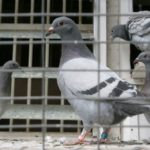If you were building a bird from scratch, and you decided that one of its primary features would be that it was ridiculously difficult to tell males from females, the chances are you’d end up with something not a million miles from your common or garden pigeon.
They are, not to put too fine a point on it, legendarily enigmatic about their sex.
Plumage difference? Not really.

Size difference? Barely, overall, if at all.
Enormously different and obvious genitals that weigh them down when they fly? Now you’re just being silly.
So how in the world do you tell your males from your females?
Well – patience and a certain primitive deductive reasoning can help you.
If you see a pigeon laying an egg – what you have there is a female. Note it as such before it slips back in with the rest of the group and certainty is lost to you for another season.
Similarly, if you separate your pigeons into groups of two, either they’ll eventually mate, or they eventually won’t, Again though, as with egg-laying, you kind of need to be there at the time in order to positively identify who does what, and who doesn’t, which makes the whole process of identification by separation somewhat tedious and time-consuming.
What’s more, whereas in some bird species, you can get a clue from who incubates the eggs, pigeons once again go out of their way to complicate matters, as males and females will take it in turns to incubate their eggs.
There’s a certain amount of pigeon-breeder’s lore that says the females incubate in the morning and the males in the afternoon, but one of the reasons that’s a piece of lore rather than a law is that pigeons will mix and match their shifts, like twins trying to see if you’re paying attention.
Very progressive, very 21st century, very useless in getting a definitive take on sex differences.
Let’s abandon such hit and miss ways of telling what’s what and who’s’ who. There are a handful of more regular ways to get an idea of which pigeon is which sex
The Claw Clue
Take a look at your pigeon’s claws. The male’s side claw is supposed to be the same length as its forward-facing claws. The female’s side-claw is supposed to be shorter than its front-facing claws.

For the most part though, pigeons make absolutely nothing easy for you, and the difference is difficult to spot with the naked eye.
You may need to strictly measure the claw-lengths to get a better idea of any sex differences that you can establish this way.
The Cloacal Clue
The anal – or more properly speaking, the cloacal vents of the male and the female pigeon are slightly different. Really slightly.
Technically, the female’s vent is slightly wider, but you’ll need sharp eyes and a certain gung-ho approach to life to measure the differences in cloacal vent-widths with enough confidence to claim you’ve identified the sex difference between two birds.
The very best of luck to you.
The Test Wing
You’ve heard of shaking a tail feather – but watching your pigeons’ tail feathers could be an indication of sex differences.
If you hold one of your pigeons up by its wings, their tail feathers will usually do one of two things. Either they’ll stick out straight from the body, or they’ll stay upright.
The stick-out-straight pigeons are – fairly reliably – males. The upright tail feathers tend – again, with a reasonable reliability – to be the females.
Sound And Fury
You know how, given any opportunity, human males will make a lot more noise than females, fueled by testosterone (and systemic privilege, but that’s another article)?
The same sort of behavior can be observed in pigeons. While both male and female pigeons coo, the males tend to be louder, and to coo more.
Whether males coo over females, or steal credit for their ideas, research has yet to show.
The Acceptance Signals
While, as we’ve said, you have to be quick and lucky to witness either pigeon mating – which tends to be over in a brief meeting of cloaca – or egg-laying, there are preparatory rituals which can give you a sex clue.

Males traditionally choose the nesting sites. While they’re off looking for the perfect place, the females stay put.
When the male feels it has found the right place, it will bring back a twig offering to the female – her role in the process is to accept or not accept the offering.
Bottom line, whoever brings the twig is the male. Whoever stays put and then says the pigeon equivalent of “Is that the best you can do?” is your female.
The Subtle Signs
While there is little in the overall appearance of pigeons that identifies them as male or female, if you check out the heads of lots of pigeons over time, you’ll get the sense that most males have slightly larger, more rounded heads, while female heads tend to be less round and have a flatter look.
Conversely, female eyes tend to look rounder, and male eyes more oval or almond-shaped.
The Unsubtle Signs
If you see a pigeon being the feathered equivalent of that drunk guy in every bar – it’s probably a male.
Generally speaking, the behaviors of male pigeons are louder, more boisterous, and more self-important.
If you see a pigeon strutting and preening – it’s a giveaway sign that the bird is a male.
While pigeons remain sexually enigmatic in many ways, the biggest and easiest giveaway of which bird is which sex probably comes down to this testosterone-fueled strut-fest.
Using the strutting behavior (and the non-strut of suspected females) to pair them up and wait for mating behavior to show itself) is almost as good as it gets in the pigeon sexing stakes.






